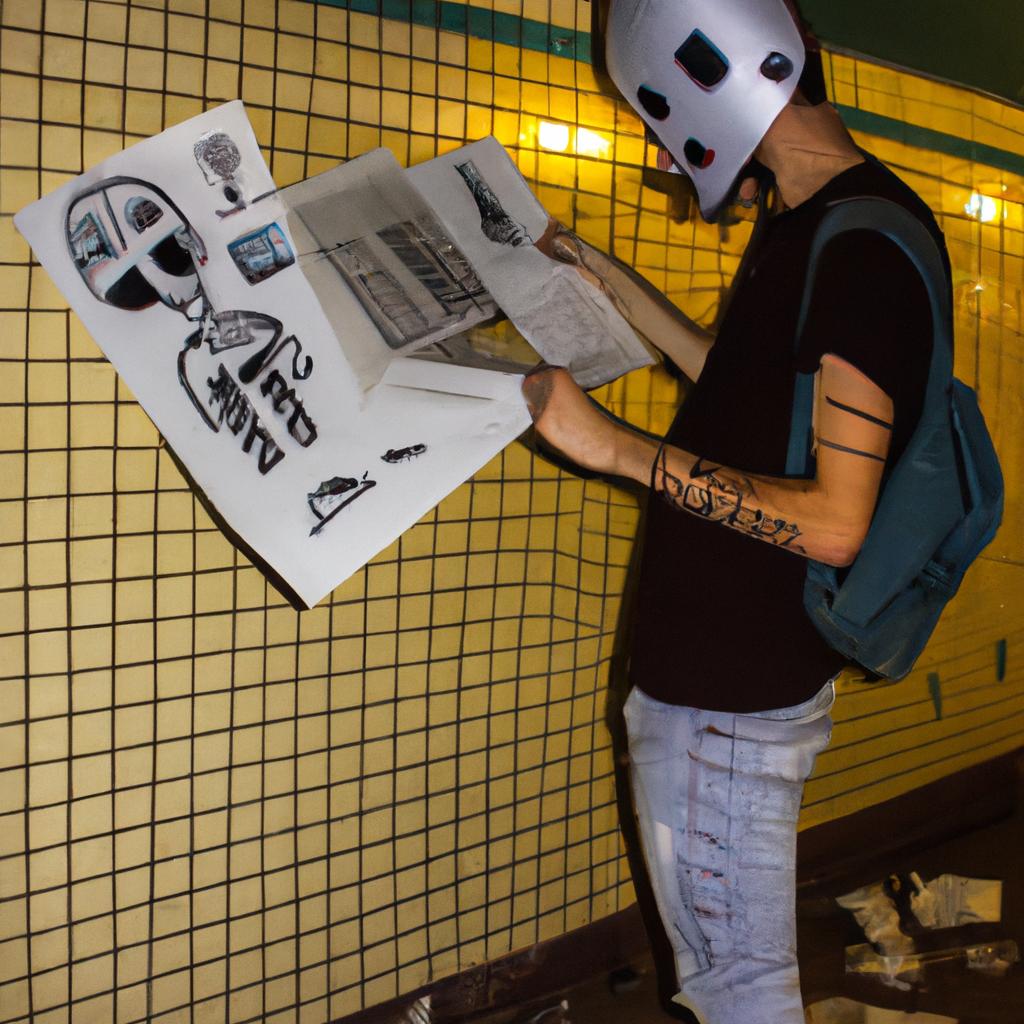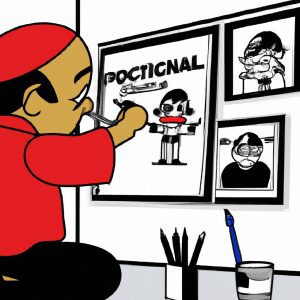Underground Comix: The Alternative Art of Comics

The world of comics has long been dominated by mainstream publications, but nestled within its subculture lies a vibrant and often controversial art form known as underground comix. These alternative comic books emerged in the late 1960s as a reaction to the restrictive content regulations imposed by the Comics Code Authority. One notable example is “Zap Comix,” created by Robert Crumb, which challenged societal norms through its explicit and satirical content. By examining the history, themes, and impact of underground comix, this article aims to shed light on this lesser-known yet influential medium.
In essence, underground comix served as an outlet for artists who sought creative freedom beyond what was permitted in traditional comic book publishing. The case study of “Fabulous Furry Freak Brothers” illustrates how these underground comix pushed boundaries with their countercultural narratives. Created by Gilbert Shelton, this series depicted the misadventures of three hippie characters engaged in drug use and anti-establishment activities. Such provocative subject matter allowed artists to address taboo topics like sexuality, drugs, politics, and social issues that were otherwise deemed unsuitable for mainstream audiences.
As we delve deeper into the world of underground comix, it becomes evident that they not only challenged conventional storytelling methods but also embraced a distinctive artistic style. The artists behind these comics often rejected the clean, polished look of mainstream publications in favor of a raw, gritty aesthetic. They experimented with unconventional panel layouts, exaggerated caricatures, and bold use of color to convey their rebellious messages. This artistic approach added another layer of subversion to the content, as it defied traditional expectations of what comic book art should look like.
One key aspect that sets underground comix apart is their emphasis on personal expression and individual perspectives. Unlike mainstream comics which aimed for broad appeal, underground comix were often highly personal and reflective of the artists’ own experiences and beliefs. This allowed for a diverse range of voices and narratives to emerge within the medium. From feminist perspectives in works like “Wimmen’s Comix” to African-American perspectives in “Black Panther,” underground comix provided a platform for marginalized groups who were underrepresented or ignored by mainstream publishers.
The impact of underground comix extends beyond their immediate cultural influence. By challenging societal norms and censorship regulations, they paved the way for greater creative freedom within the comics industry as a whole. Many themes and storytelling techniques introduced by underground comix have since been adopted and expanded upon by mainstream creators. Additionally, these alternative comics helped establish independent publishing as a viable option for aspiring artists who wanted to bypass corporate gatekeepers.
In conclusion, underground comix played an integral role in pushing boundaries and expanding the possibilities within the world of comics. Through their explicit content, countercultural narratives, unique artistic styles, and promotion of diverse voices, they challenged societal norms while inspiring future generations of creators. Though often controversial and divisive, their impact on the medium cannot be denied, making them an important part of comic book history that deserves recognition and appreciation.
History of Underground Comix
History of Underground Comix
In the mid-20th century, a countercultural movement emerged within the realm of comic art that challenged mainstream conventions and paved the way for an alternative form known as underground comix. These comix represented a departure from traditional superhero narratives and ventured into taboo subjects such as sex, drugs, and political dissent. One notable example is Robert Crumb’s “Zap Comix,” which gained notoriety for its provocative content and distinctive artistic style.
The rise of underground comix can be attributed to several key factors. Firstly, it was influenced by the broader cultural changes taking place during the 1960s and 1970s in America. As society became more open-minded and politically engaged, artists sought new avenues to express their unconventional ideas and challenge societal norms. The counterculture movement provided fertile ground for these artists to experiment with narrative styles, visual aesthetics, and subject matter that had previously been deemed inappropriate or unacceptable.
To understand the impact of underground comix on society at large, one must recognize its ability to provoke emotional responses through various techniques. For instance, bullet points can serve as effective tools for conveying information concisely while evoking an emotional response from readers:
- Subversive themes: Underground comix tackled controversial topics such as sexuality, drug use, and social inequality head-on.
- Artistic freedom: Artists were able to explore non-traditional drawing styles and experimental storytelling methods without censorship constraints.
- Cultural commentary: Underground comix often served as a platform for critical social commentary on issues like civil rights, feminism, and war.
- Marginalized voices: These comics gave voice to marginalized groups that were underrepresented in mainstream media.
Furthermore, a table can also be employed to visually highlight specific examples within this context:
| Artist | Notable Work | Contribution |
|---|---|---|
| Robert Crumb | “Zap Comix” | Provocative content and distinct artistic style |
| Aline Kominsky | “Twisted Sisters” | Feminist perspective on women’s issues |
| Gilbert Shelton | “The Fabulous Furry Freak Brothers” | Satirical critique of counterculture and society |
| Trina Robbins | “It Ain’t Me, Babe” | Representation of female experiences |
In conclusion, the emergence of underground comix can be seen as a response to societal changes during the countercultural era. Through subversive themes, artistic freedom, cultural commentary, and amplification of marginalized voices, these alternative comics challenged established norms and provided an outlet for creative expression.
Transition: The intertwining nature of counterculture movements with underground comix sheds light on their symbiotic relationship. Let us explore this connection further.
Counterculture and Underground Comix
One notable example of the impact of underground comix on mainstream comics is the case of Robert Crumb. Crumb, a prominent figure in the underground comix movement, gained recognition for his controversial and subversive artwork. His comic “Fritz the Cat,” which featured explicit content and challenged societal norms, was eventually adapted into an animated film by mainstream studios. This crossover from alternative to mainstream media illustrates how underground comix pushed boundaries and influenced the wider comic industry.
The influence of underground comix can be seen through several key aspects:
- Artistic Freedom: Underground comix provided artists with an outlet for unrestricted self-expression, allowing them to explore unconventional themes and styles that were often deemed unacceptable within the confines of mainstream publishing.
- Social Commentary: Many underground comix tackled taboo subjects such as sexuality, politics, and drug culture, offering a platform for social critique and commentary on contemporary issues.
- Diverse Representation: In contrast to mainstream comics’ predominantly white male protagonists, underground comix embraced diversity by featuring characters from different racial backgrounds, genders, and sexual orientations.
- Do-It-Yourself Ethic: The production process of underground comix often involved self-publishing or small independent presses, fostering a DIY ethos that empowered creators to have full control over their work.
| Aspects | Characteristics |
|---|---|
| Artistic Freedom | Unrestricted self-expression |
| Social Commentary | Critique of taboos & current affairs |
| Diverse Representation | Characters reflecting various identities |
| Do-It-Yourself Ethic | Independent publishing & creative autonomy |
Overall, the impact of underground comix went beyond its niche readership; it left an indelible mark on mainstream comics by challenging conventions and expanding artistic boundaries. In our next section on “Themes and Content of Underground Comix,” we will delve deeper into the subject matter explored by these alternative comics, shedding light on their contribution to the broader cultural landscape.
Themes and Content of Underground Comix
Building on the countercultural movement, underground comix emerged as a vibrant and alternative art form that challenged conventional norms of comic storytelling. With their distinctive themes and content, these comics became a powerful medium for social commentary and personal expression.
One example that exemplifies the unique themes explored in underground comix is Robert Crumb’s iconic work “Zap Comix.” In this series, Crumb delved into controversial subject matter such as sexuality, drug use, and political satire. By pushing boundaries with explicit imagery and unfiltered narratives, Crumb captured the raw essence of counterculture through his drawings.
To further understand the range of themes found within underground comix, let us examine some common elements prevalent in this artistic movement:
- Social Critique: Underground comix served as a platform for artists to critique societal issues ranging from civil rights and feminism to government corruption.
- Personal Reflections: Many creators used their work to explore personal experiences such as relationships, mental health struggles, and identity formation.
- Humor and Satire: Through dark humor and biting satire, underground comix often challenged mainstream conventions by mocking authority figures or traditional values.
- Experimental Storytelling: Unlike mainstream comics that adhered to established structures, underground comix embraced experimental approaches like non-linear narratives or abstract imagery.
| Themes Explored in Underground Comix |
|---|
| Sexuality |
| Drug Use |
| Political Satire |
| Civil Rights |
- These comics not only entertained but also provoked thought-provoking discussions about society’s taboos.
- The graphic nature of the artwork added intensity to the emotional impact experienced by readers.
- The juxtaposition of humorous elements with serious subjects heightened the overall effect of these works.
- Artists’ willingness to share personal stories fostered empathy among readers, creating a deeper connection to the material.
It is important to recognize that underground comix did not adhere to traditional rules of comic storytelling. By challenging societal norms and embracing unconventional techniques, these comics paved the way for future generations of artists seeking alternative modes of expression.
The impact and influence of underground comix extended far beyond their countercultural origins, shaping contemporary comics and inspiring new waves of creators eager to break free from established conventions.
Impact and Influence of Underground Comix
Underground Comix: The Alternative Art of Comics
In exploring the themes and content of underground comix, one notable example is Robert Crumb’s “Zap Comix.” Released in 1968, this influential publication pushed boundaries with its explicit depictions of sex, drugs, and countercultural ideologies. These themes were not limited to “Zap Comix” alone; they permeated much of the underground comix movement during the late 1960s and early 1970s.
The content found within these alternative comic books often served as a form of social commentary or critique. Artists used their work to challenge societal norms, address political issues, and question authority. By delving into taboo subjects such as sexuality, drug use, and racial discrimination, underground comix provided an outlet for artists to express themselves freely without censorship.
One way in which these themes were conveyed was through the inclusion of graphic sexual imagery. For some readers, encountering explicit scenes may have been shocking or uncomfortable. However, it allowed artists to explore human sexuality openly and discuss topics that were typically considered too risqué for mainstream comics. This unabashed approach aimed to break down societal taboos surrounding sex while also presenting a more realistic depiction of relationships and desire.
To further understand the impact of underground comix on society, let us consider a few key emotional responses evoked by their content:
- Shock: The explicit nature of certain scenes challenged traditional notions of decency.
- Empowerment: Underground comix gave marginalized voices a platform to be heard.
- Disgust: Some readers may have felt repulsed by the graphic violence depicted in certain stories.
- Liberation: The unfiltered expression within these comic books offered a sense of freedom from societal constraints.
Table: Themes Explored in Underground Comix
| Theme | Description |
|---|---|
| Sexuality | Graphic and explicit scenes aimed to challenge norms. |
| Political Critique | Addressing sociopolitical issues through art. |
| Drug Culture | Exploring the influence of drugs on counterculture. |
| Underground Lifestyle | Depicting alternative lifestyles outside mainstream. |
As we delve into the next section about “Censorship and Legal Battles,” it is important to understand that the themes and content explored in underground comix were not without controversy. The unapologetic nature of these comic books often led to clashes with authorities, both legal and cultural, as they challenged prevailing notions of acceptability within society. By examining these battles, we can gain insight into the broader context surrounding this alternative form of artistic expression.
[Censorship and Legal Battles] Despite facing numerous challenges, underground comix persevered and left a lasting impact on the world of comics, paving the way for future generations of artists to push creative boundaries even further.
Censorship and Legal Battles
Following the impact and influence of underground comix, it is essential to examine the censorship and legal battles that emerged as a result. One notable case study involves the trial of cartoonist R. Crumb for obscenity charges in 1972. His comic book, “Zap Comix #4,” was deemed offensive by authorities due to its explicit content and portrayal of taboo subjects such as sex and violence.
Censorship against underground comix arose from concerns about their subversive nature challenging societal norms. It led to intense legal battles aimed at suppressing this alternative art form. These conflicts often centered around freedom of expression versus community standards, raising important questions about the limits of artistic liberties within society.
The fight against censorship took various forms, including legal challenges mounted by artists and publishers defending their work. The following bullet points highlight key aspects of this ongoing battle:
- Artists actively sought to challenge established conventions through provocative content.
- Publishers faced increasing pressure from both conservative groups and government agencies.
- Legal precedents were set regarding what constituted obscenity in comics.
- Some underground comix creators embraced self-publishing to avoid mainstream restrictions.
To further understand the complexities surrounding censorship and legal battles during this period, consider the following table:
| Key Players | Arguments Against | Arguments For | Outcome |
|---|---|---|---|
| R.Crumb | Artistic Expression | Offensiveness | Found not guilty |
| Underground Publishers | Freedom of Speech | Community Standards | Mixed rulings |
| Government Agencies | Protecting Morality | Upholding Laws | Varied decisions |
These examples illustrate how debates over obscenity challenged traditional notions of art, speech, and morality within society.
As we delve into the legacy of underground comix, it becomes evident that these encounters with censorship had profound implications for the art form. The legal battles fought by artists and publishers reshaped public perceptions of comics, paving the way for greater acceptance and recognition as a legitimate medium of artistic expression.
Transitioning into the subsequent section on the legacy of underground comix, it is crucial to examine how these struggles against censorship contributed to shaping the future landscape of alternative comics.
Legacy of Underground Comix
Shedding light on the tumultuous history of censorship and legal battles faced by underground comix, it is important to explore the lasting impact and legacy they have left behind.
The alternative art form of underground comix continues to resonate with audiences today. One notable example that exemplifies its enduring influence is “Maus” by Art Spiegelman. This graphic novel tells the story of Spiegelman’s father surviving the Holocaust, using anthropomorphic animals as characters. Through this unique approach, “Maus” challenges preconceived notions about what comics can achieve as a medium for exploring complex themes such as trauma and historical events.
The legacy of underground comix is multifaceted, leaving an indelible mark on both the comic book industry and broader cultural landscape. Here are some key aspects that contribute to their ongoing significance:
- Counter-cultural Rebellion: Underground comix emerged as a rebellious response against mainstream societal norms in the 1960s and 1970s. They provided a platform for marginalized voices, challenging established power structures through provocative content.
- Artistic Freedom: These comics pushed boundaries and defied conventional storytelling techniques, allowing artists to experiment with unconventional narratives and visual styles.
- Social Commentary: Underground comix often served as vehicles for social commentary, tackling issues such as politics, sexuality, racism, gender inequality, and drug use head-on.
- Alternative Distribution Networks: The creation of grassroots distribution networks helped ensure these comics reached their intended audience while circumventing traditional publishing channels.
| Aspects | Impact | Examples |
|---|---|---|
| Counter-cultural Rebellion | Challenged societal norms | Zap Comix |
| Artistic Freedom | Pushed creative boundaries | Raw Magazine |
| Social Commentary | Addressed pressing issues | Wimmen’s Comix |
| Alternative Distribution Networks | Access to alternative markets | The East Village Other |
The legacy of underground comix lives on, influencing subsequent generations of comic book creators and challenging the boundaries of what can be achieved within the medium. By embracing the power of visual storytelling and unapologetic self-expression, these comics have cemented their place in history as a vital form of artistic resistance.
[End of section]



